Parents for Healthy Schools

Parents have a powerful role in supporting children’s health and learning. Engaged parents help guide their children successfully through school, advocate for their children, and can help shape a healthy school environment.1 CDC has developed a set of resources called Parents for Healthy Schools to help schools and school groups (e.g., parent teacher associations (PTA), parent teacher organizations (PTO), school wellness committees) engage parents to create healthy school environments.
These resources will:
- Educate parents about
- School nutrition environment and services
- School-based physical education and physical activity
- Managing chronic health conditions in school settings
- Provide parents with practical strategies and actions to improve the school health environment
- Provide suggestions for ways to track progress in engaging parents in changing the school health environment.
- Parent Engagement
- Nutrition
- Physical Activity
- Chronic Health Conditions
- e-Learning Course
- Promotion Kit
- Strategy Document
Parent engagement in schools is defined as parents and school staff working together to support and improve the learning, development, and health of children and adolescents.2, 3 Parent engagement in schools is a shared responsibility in which schools and other community agencies and organizations are committed to reaching out to engage parents in meaningful ways, and parents are committed to actively supporting their children’s and adolescents’ learning and development.
When parents are engaged in their children’s school activities, their children get better grades, choose healthier behaviors, and have better social skills.4 In addition, school health activities are more successful when parents are involved.5
Drawing from research and best practices from schools across the country, the CDC created strategies for parent engagement in school health to give schools a framework for engaging parents in school health activities. Below are the three aspects of the parent engagement framework:
- Connecting with parents
- Engaging parents in school health activities
- Sustaining parent engagement in school health
Using this framework, CDC in collaboration with other key partners developed Parents for Healthy Schools.
Parents for Healthy Schools
- Parents for Healthy Schools: A Guide for Getting Parents Involved from K-12 [PDF 9.3 MB]—Provides an overview of a healthy school environment with a focus on the school nutrition environment and services, physical education and physical activity, and managing chronic health conditions in schools; an overview of the framework for engaging parents in school health; and suggestions for how to use the resources.
- Parents for Healthy Schools: Making a Difference in Your Child’s School PowerPoint Presentation [PDF – 7 MB] [PPT 9 MB]—Makes the case for healthy school environments, provides suggestions for improvement, and identifies ways parents can take action. An evaluation form [PDF – 2 MB] is included.
- Ideas for Parents—Share ideas for how parents can take action to improve school health environments:
- Check-in Questions [PDF – 1.4 MB]—Identifies ways to track progress in engaging parents in changing the school health environment.
Effective Ways Schools Can Use These Resources
- Use the Guide to identify ways to deliver the PowerPoint Presentation and Ideas for Parents and track parent engagement using the check-in questions.
- Deliver the PowerPoint Presentation to parents through PTA/PTO meetings, school wellness committee, or other networks such as the National Network of Partnership Schools.
- Give parents the Ideas for Parents to share ways they can become involved in making changes in the school health environment.
- Look for signs of change and collect parent feedback using the check-in questions and the evaluation form for the PowerPoint Presentation.
References
- Centers for Disease Control and Prevention. Parent Engagement: Strategies for Involving Parents in School Health. Atlanta, GA: U.S. Department of Health and Human Services; 2012.
- Epstein JL. School, Family, and Community Partnerships: Preparing Educators and Improving Schools Second Edition. Boulder, CO: Westview Press; 2011.
- National Family, School, and Community Engagement Working Group: Recommendations for Federal Policy. Cambridge, MA: Harvard Family Research Project; 2009.
- Resnick MD, Bearman PS, Blum RW, Bauman KE, Harris KM, Jones J, et al. Protecting adolescents from harm. Findings from the National Longitudinal Study on Adolescent Health. Journal of the American Medical Association 1997;278(10):823–832.
- Ornelas IJ, Perreira KM, Ayala GX. Parental influences on adolescent physical activity: a longitudinal study. International Journal of Behavioral Nutrition and Physical Activity 2007;4(3):1–10.
|
Schools provide students with opportunities to learn about and practice healthy eating. The school nutrition environment refers to the foods and beverages that are available to students throughout the school day, as well as information and messages about food and nutrition that students encounter on school grounds. Ideas for Parents provides information and suggestions for how parents can get involved in the following aspects of the school nutrition environment and services: |
|
|
|
|

|
Nutrition Model and Infographic
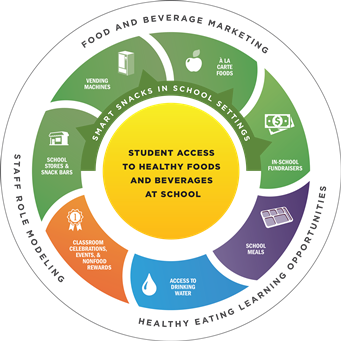
|
The CDC recommends that schools implement policies and practices to create a nutrition environment that supports students in making healthy choices by providing them with access to healthy and appealing foods and beverages, consistent and accurate messages about healthy eating, and opportunities to learn about and practice healthy eating. |
| Click to Enlarge | |
| PDF [PDF – 5.5 MB] | JPEG | PNG | |

|
The CDC and other national organizations recommend that schools do the following: provide a quality school meal program; ensure that students have only appealing, healthy food and beverage choices offered outside of the school meal program; market healthy foods and beverages; and use fundraising activities and student rewards that support health. The goal is to ensure that students have access to healthy food choices during the school day and messages that reinforce these choices. However, there is still much work to be done. |
| Click to Enlarge | |
| PDF [PDF – 581 KB] | JPEG | PNG |
|
Schools can create an environment that offers many opportunities for students to be physically active throughout the school day. A Comprehensive School Physical Activity Program provides a national framework for school-based physical education and physical activity. A Comprehensive School Physical Activity Program provides strong coordination for five components: physical education, physical activity during school (recess and classroom physical activity), physical activity before and after school, staff involvement, and family and community engagement. Ideas for Parents provides information and suggestions for how parents can get involved in the following aspects of physical education and physical activity that align with a comprehensive school physical activity program: |
|
|
|
|

|
Comprehensive School Physical Activity Program Model and Physical Activity in Schools Infographic

|
The CDC and other national organizations recommend a comprehensive, school-wide approach to physical activity that provides opportunities for students to be physically active before, during, and after the school day. A Comprehensive School Physical Activity Program (CSPAP) has five components: physical education, physical activity during school, physical activity before and after school, staff involvement, and family and community engagement. |
| Click to Enlarge | |
| PDF [PDF – 527 KB] | JPEG | PNG | |
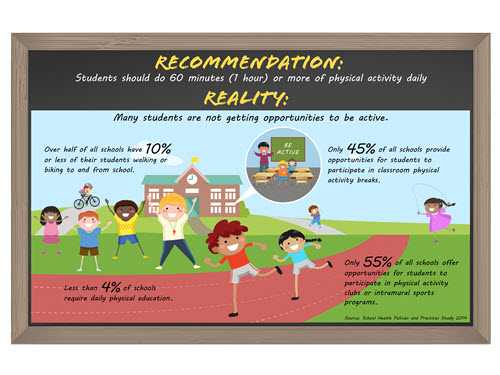
|
The federal Physical Activity Guidelines for Americans recommends that children and adolescents should do 60 minutes (1 hour) or more of physical activity daily. However, most students are not meeting this recommendation, and many schools are not providing opportunities to help students be more physically active to meet this recommendation. |
| Click to Enlarge | |
| PDF [PDF – 731 KB] | JPEG | PNG |
|
Schools can support students with chronic conditions to be healthy and ready to learn. Many schools offer health services and may have a full-time registered nurse or other health staff to help students with emergencies, as well as managing chronic health conditions. Some school districts may have school-based health centers that can deliver direct medical, dental, nutritional, and mental health services to students and sometimes their families. Ideas for Parents provides information and suggestions about how parents can support schools in managing students with chronic conditions in areas including the following: |
|
|
|
|

|
Chronic Health Conditions in Schools Model and Infographic
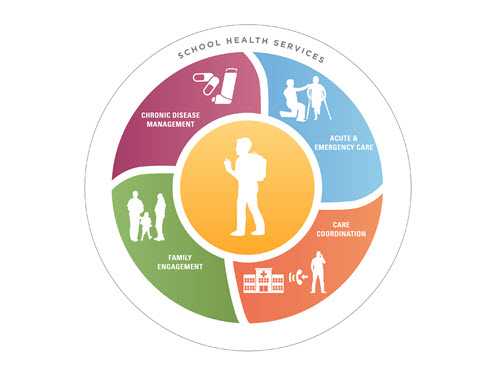
|
For children who have chronic health conditions, having access to student health services is critical to help them with daily management, as well as for acute or emergency care. Family engagement, care coordination, and communication with the family’s health care provider are all essential components to helping students stay healthy and ready to learn. |
| Click to Enlarge | |
| PDF [PDF – 466 KB] | JPEG | PNG | |
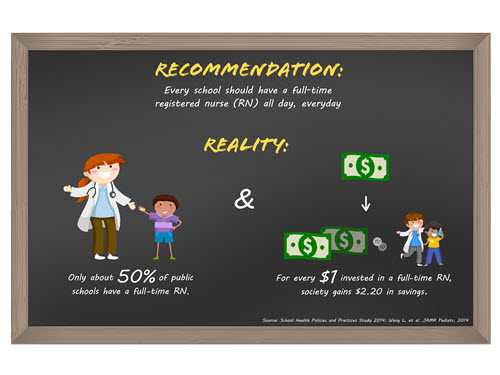
|
The National Association of School Nurses states that every school-aged child deserves a registered nurse, and every school should have a full-time school nurse all day, every day; however, many schools across the United States do not meet this recommendation. |
| Click to Enlarge | |
| PDF [PDF – 578 KB] | JPEG | PNG |
Parents for Healthy Schools e-Learning Course
The purpose of the Parents for Healthy Schools module is to provide resources to motivate and educate parents to be part of creating a healthy school environment.
The course provides guidance on how to:
- Use and share resources developed for Parents for Healthy Schools.
- Use the parent engagement framework of connecting, engaging, and sustaining.
- Provide ways for parents to help create a healthy school environment.
| Promote the resources for Parents for Healthy Schools to your partners and constituents. Download the Parents for Healthy Schools Promotion Kit [PDF – 1 MB] for information to share in your organization’s newsletter, social media outlets, blog, or listserv. | |
|
|
|
|
|
Parents for Healthy Schools Resources
- Parents for Healthy Schools: A Guide for Getting Parents Involved from K-12 [PDF 9.3 MB] —Provides an overview of a healthy school environment with a focus on the school nutrition environment and services, physical education and physical activity, and managing chronic health conditions in schools; an overview of the framework for engaging parents in school health; and suggestions for how to use the resources.
- Parents for Healthy Schools: Making a Difference in Your Child’s School PowerPoint Presentation [PDF – 4.3 MB] [PDF – 9.9 MB] —Makes the case for healthy school environments, provides suggestions for improvement, and identifies ways parents can take action. An evaluation form [PDF – 2 MB] is included.
- Ideas for Parents—Share ideas for how parents can take action to improve school health environments:
- Check-in Questions [PDF – 1.4 MB]—Identifies ways to track progress in engaging parents in changing the school health environment.
Who Developed These Resources?
The Centers for Disease Control and Prevention (CDC) in collaboration with:
In 2012, CDC released Parent Engagement: Strategies for Involving Parents in School Health, which defines and describes engagement between parents and school staff and identifies specific strategies for all three aspects of parent engagement in schools: connect, engage, and sustain. In addition, use CDC’s Promoting Parent Engagement in School Health: A Facilitator’s Guide for Staff Development to help you develop a plan for engaging parents in school health activities. Both of these resources provide the evidence-based framework for Parents for Healthy Schools.
Parent Engagement Fact Sheets
- Overview Brochure [PDF – 4 MB]
- For School Districts and School Administrators [PDF – 872 KB]
- For Teachers and Other School Staff [PDF – 765 KB]
- For Parents and Families [PDF – 741 KB]
- Page last reviewed: September 5, 2017
- Page last updated: September 5, 2017
- Content source:


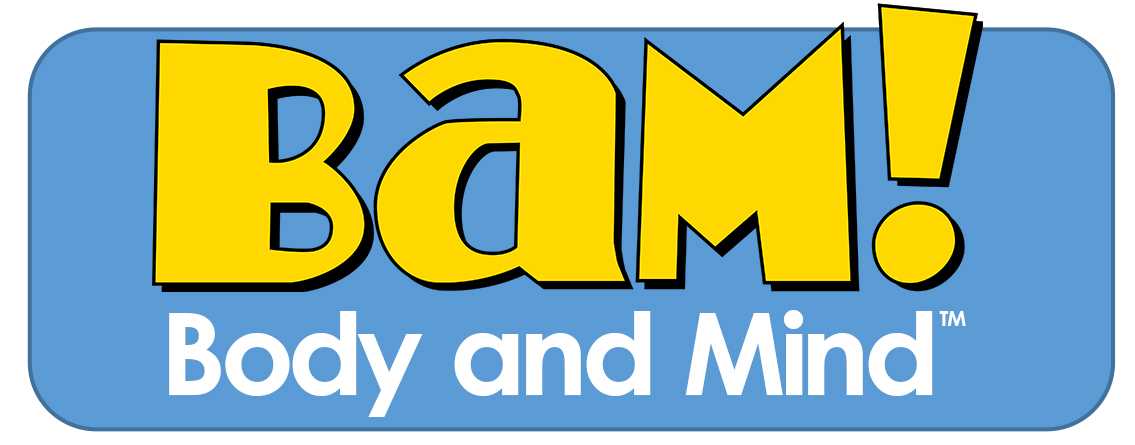
 ShareCompartir
ShareCompartir

